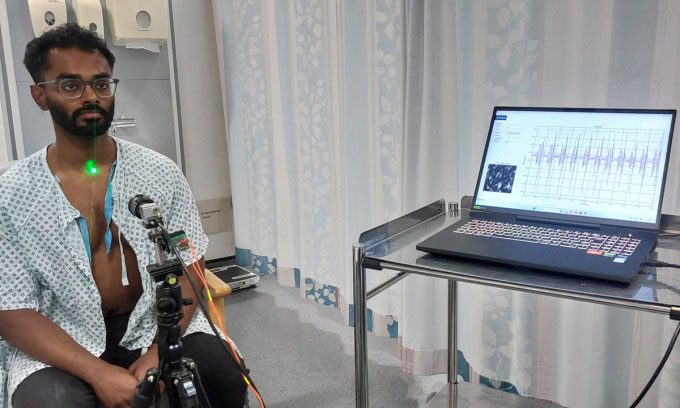The new system uses high-speed cameras combined with artificial intelligence to monitor patients’ heart rates and detect abnormalities.
Scientists at the University of Glasgow, Scotland, have developed a laser camera system that measures a person’s heart rate from a distance and identifies signs that may indicate cardiovascular diseases. This new system employs quantum technology and artificial intelligence (AI), which could transform how individuals monitor their health, The Guardian reported on December 3rd.

A patient being monitored at Queen Elizabeth Hospital in Greenwich. (Photo: Guardian).
“The system can be set up in kiosks at shopping centers, where people can quickly check their heart rates, and then add data to their online health records. Additionally, the laser heart rate monitor can be installed at home as part of a system that tracks various health parameters,” said Daniele Faccio, a professor at the University of Glasgow’s Advanced Research Center.
Faccio added that remote heart rate monitoring is particularly beneficial because abnormalities, such as murmurs or heart rates that are too fast or too slow, can alert patients at risk of stroke or cardiac arrest.
Currently, doctors use stethoscopes to monitor heart rates. “You need training to use a stethoscope correctly. Pressing too hard on the patient’s chest can diminish the heart rate signal. At the same time, this method may not effectively detect heart murmurs, which provide important clues about defects, occurring behind the main heart rhythm,” Faccio explained.
The system developed by Faccio’s team includes high-speed cameras capable of recording at 2,000 frames per second. A laser beam is projected onto the patient’s neck, and the reflected light is used to accurately measure the skin’s expansion and contraction caused by the main artery dilating and contracting as blood flows through it. These changes include shifts of just a few billionths of a meter.
“We use advanced computing systems to filter out everything except the vibrations caused by the human heart, even though these vibrations are much weaker than other sounds emanating from the chest. We know the frequency range of human heartbeats, and AI will focus on that,” Faccio stated.
Faccio’s team hopes the new system will be ready for use next year. “This system is highly accurate. Even if you are in the same house with 10 other people, it can still distinguish you from others by projecting a laser onto your neck and analyzing your heart rate from the reflected data. In fact, another application of the system is biometric identification. However, the primary purpose of this new technology will be to measure heart rates quickly and easily, outside of hospitals or clinics. The potential benefits could be substantial,” he noted.



















































